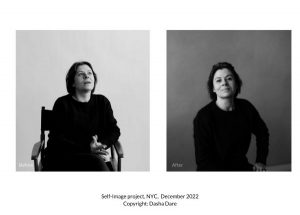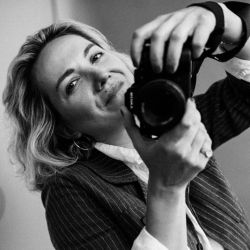A Coach Who Photographs: The Power of Photography in Coaching
For many years before receiving my coach training and ICF credential, I worked with clients one-on-one in a photo studio setting.
Looking back, I see that my photography experience has been invaluable preparation for my coaching work. A traditional portrait photoshoot includes the coaching elements of holding space, listening, observing, supporting, partnering, and capturing something powerful about clients they might not see for themselves.
However, one aspect of coaching that I was missing in photography was the shared reflection experience — the discussion of what each image stands for, what clients see versus what I see, and so on.
This thinking inspired me to bring my camera into my coaching sessions.
At first, I did it to record progress. Every coaching session affects a person on the other side of the computer screen, and by recording these changes through pictures at the end of your coaching engagement, you’ll create a folder of memories with time stamps of various points of growth and self-discovery.
A picture is worth 1,000 words. A folder of pictures from the coaching session is worth hours of proving the effectiveness of coaching and justifying the investment.
To dig a little deeper into portrait photography, one needs to understand that the image I am working with as a photographer is the client’s self-image. It is rather primitive, in my opinion, to look at the picture-taking as merely a process of making an imprint of physical shape and form. Our form is only so important as it tells ourselves and the world around us about our inner world.
So, there is a shape and a form that represents something bigger. There is the observer and the observed, or as some of the spiritual teachers would say, “The seer, the seeing, and the seen.”
All of this matters as it affects how we see ourselves and the gap between our current self-image and the one we desire. This common place is where coaching sessions often start. Questions arise: How do I see myself? How does the world see me? What’s in the way?

When conducting my self-image project with a few volunteers, I challenged myself to take two pictures before and after the coaching session and see if there was a difference. The goal for the last picture was to capture a person relaxing into their greatness — which is ultimately their ideal self.
The results of this experiment spoke for themselves. One participants shared, “In the photographs after the session, I looked exactly like how I would like the world to see me, how I would like to see myself – peaceful, calm, and happy to be who I am.”
Throughout 2023, I’ve gradually introduced photography into all of my coaching sessions, whether it’s one-off calls or a long-term engagement.
As part of my presentation “Feeling Seen: Photography in Coaching on Self-image” at ICF Converge 2023 last year, I shared the method of coaching I’ve been developing most recently — the #DareMethod.
Introducing the Dare Method
The #DareMethod uses photography to help us see ourselves differently and therefore shorten the process of transformation. In short, the essential steps of #DareMethod approach are:
1). First Optional Step: Photo Introduction
- Take a photo of the client at the beginning of the session.
2). Regular Coaching Session
- Engage in a regular coaching session following a structured coaching arc.
3). Introduction to Quantum Mechanics
- Introduce the foundations of quantum mechanics and explore the multiple potentials available to individuals at any given time as part of the coaching arc.
4). Guided Meditation Exercise
- Conduct a guided meditation exercise inviting the client to visualize their ideal self and experience the feelings associated with that ideal self.
5). Post-Meditation Photo
- After the guided meditative exercise, capture another photo of the client.
6). Shared Screen Experience
- Share the screen with the client and review the newly captured photo together.
7). Reflect on the Experience
- Invite the client to reflect on their experience during the session and the person captured in the photo.
8). Symbolic Reflection
- Invite the client to reflect on what this picture symbolizes and represents for them personally.
For most of us, reality is defined and measured by time and space. It needs to be recognized by our faculty of perception for us to make sense of it, making any transformation time-consuming as we are constantly in the process of waiting for the physical reality to catch up.
Seeing Through the Lens
 “Seeing is believing” perfectly describes our 3D world. However, the statement “Blessed are those who have not seen but yet believe” suggests that belief based on sight is inferior.
“Seeing is believing” perfectly describes our 3D world. However, the statement “Blessed are those who have not seen but yet believe” suggests that belief based on sight is inferior.
So, it must be possible for us to create change without seeing its manifestation in physical reality. “Even though my eyes are not seeing me being transformed, I know that transformation has already taken place. Therefore, I act as if it has already happened.” In application to the #DareMethod, this means that the same image of the client can represent two identities: past and present/future.
According to the #DareMethod approach, the photo I take during our coaching session serves to redefine what this image stands for. This occurs toward the end of the session when we review the photo together. Through the power of coaching questions, we can awaken awareness in the client about the deeper meaning of everything we see and perceive beyond the surface level. What is real for you now? What is possible for this person in this image? What does it feel like to be this person?
Typically, the shift that has taken place within the client during the session is evident in the photo. Sometimes, simply sharing a screen and letting the client stay with their photo silently is an even more powerful experience than discussing it. The coach’s presence is very important throughout this entire experience and cannot be underestimated. The coach becomes a witness of transformation, a record keeper for the client. Because the coach captures this transformation, the reality of the experience becomes undeniable for the client.
In conclusion, if we can learn to re-assign the meaning to that which we see and have faith in that new meaning despite the information our senses deliver, we can talk about liberating ourselves from past limitations. No longer will our reflection in the mirror stand for only what is known to us. It is now a symbol of everything that is possible.
The self-image that has always been seen by the coach becomes suddenly very real for the client as well.
Isn’t that the coaching outcome we all want?
Copyright: Dasha Dare and #DareMethod



